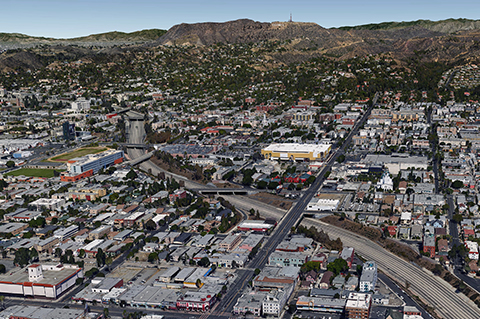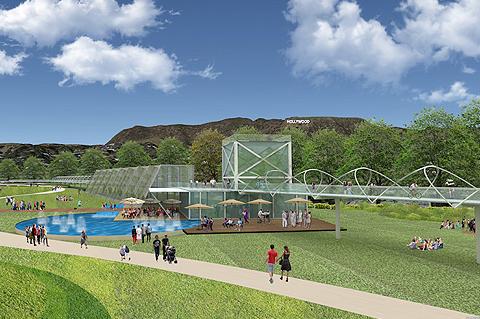Looking north to the famous Hollywood sign, the proposed park on top of the 101 Freeway will bring green space to a dense urban area.
Freeway 'CAP' Park Gains Momentum
For years it may have seemed little more than a dream: a 44-acre expanse of green, public space covering a mile of the congested 101 Freeway as it chugs through the heart of Hollywood.
But proponents of the Hollywood Central Park say they’re finally making progress both at Los Angeles City Hall, where an administrative Draft Environmental Impact Report is currently under review, and in Sacramento, where elected leaders are looking at public health differently amid the Coronavirus pandemic.
The concept, used around the world, is a “deck park,” where a sturdy platform is built over the freeway, and the park’s trees and playing fields are planted over that. The new park sits on top of the deck, while allowing vehicles to move underneath.
The park will include ball fields, fountains, an amphitheater, cafes, and bike paths. It could even host attractions and events for the 2028 Olympics.
The ambitious project will generate about 4,500 skilled construction jobs, and it will be built under a Project Labor Agreement with the LA/Orange Counties Building and Construction Trades Council.
The PLA with the Building Trades is crucial to success, organizers said.
“I would never do it without a union,” said Laurie Goldman, President of Friends of the Hollywood Central Park. “It’s important that we make sure our unions are strong in our state.”

Looking south toward Downtown LA, the park would cover 44 acres.
Health Benefits
Hollywood happens to be one of the most park-poor communities in California, and proponents say the project would be a major leap toward addressing the unfair distribution of public open spaces in the city.
They see it as a way of reuniting two sides of the same neighborhood, cleaved by the 101 when it was built from the 1920s through the 1960s.
“There has been a confluence of opportunities, where both our elected leaders and our communities are saying, ‘We need to build it now.’ They see this as a realistic project and one that will have health and community benefits,” said Alfred Fraijo Jr., Chairman of FHCP. “We know the need for open space is greater, and officials and the public are realizing green spaces contribute to public health, so that’s galvanized it.”
He added, “It really is critical to have nearby open space for the community in Hollywood, where we have 40,000 children within walking distance of the park.”
Funding will be from a public-private partnership, and FHCP wants to build on current momentum to get through approvals so they’re shovel-ready when new stimulus funds become available.
“Funding continues to be an important part of our work. In terms of public funding, we do have a lot of discussions underway at the federal and state level,” Fraijo said. “One thing we’re looking at is funding it as an infrastructure project as well, and the unique funding sources that exist for those are great. There is plenty of money out there for shovel-ready projects, so we want to make sure we get ours approved so we can take advantage of those financing tools.”

The 101 Freeway cut through Hollywood when it was constructed between the 1920s and 1960s..
That’s where the partnership with the Building Trades plays a big part, Fraijo said. “We think union labor is the only way to get it done. We need expert and skilled labor, and working early in consultation with the Trades and Council will be key to our success. We know projects that work through the approval process with organized labor have the momentum we need to get to the finish line.”
A job fair targeting those who live in ZIP Codes near the park is planned. “One of the things that’s quite exciting is the job fair,” Goldman said. “Because we’re in a federal promise zone, one of the first five President Obama created, we can do local hire.”
While freeway “cap” parks are not new, organizers say there have been some challenges to navigate. The park’s position over the 101 (the freeway will become a tunnel underneath) means that along with the city, the state of California’s Caltrans is a responsible agency with review authority. The park will need to coordinate construction and maintenance with Caltrans.
“For us, it’s been a learning process. It is a park project, not a typical infrastructure project. So that’s required Caltrans to retool the approach to the permitting process for projects that abut their facilities. We’re making progress on that,” Fraijo said.
Freeway caps have long flourished in other states since the first one was built in Seattle in the late 1970s. Currently, there are plans for several in Southern California, including over the 134 Freeway in Glendale, and at the concrete gorge where the 101 dips in Downtown LA before fanning out into a tangle of other freeways.
“There are more than 160 deck parks in the US. We’re late to the game in LA,” Goldman said. “Many states are on their third or fourth deck park. Anywhere there’s a freeway below street level, you can deck it to make a park. They’re on their fifth deck park in Seattle, Dallas is on their second, Minnesota on their fourth. So they’re all over.”
source: Building Trade News









